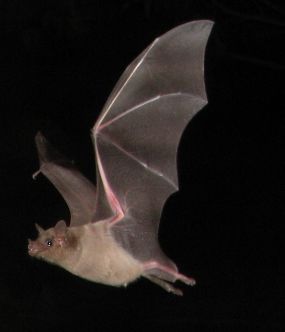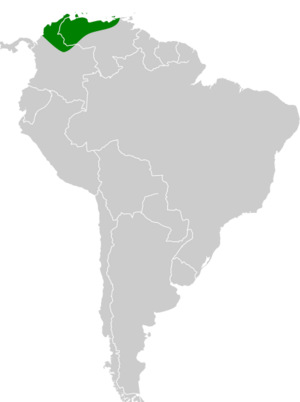Southern long-nosed bat facts for kids
Quick facts for kids Southern long-nosed bat |
|
|---|---|
 |
|
| Conservation status | |
| Scientific classification | |
| Genus: |
Leptonycteris
|
| Species: |
curasoae
|
 |
|
The southern long-nosed bat (Leptonycteris curasoae) is a fascinating bat that lives in South America. It belongs to a family of bats called Phyllostomidae. These bats are known for their unique long noses and their important role in nature.
Contents
What Does the Southern Long-Nosed Bat Look Like?
Southern long-nosed bats are medium-sized bats. They are not as big as the greater long-nosed bat and not as small as the lesser long-nosed bat.
They have soft, greyish-brown fur. Their snout, which is their nose area, is long and narrow. They also have short ears and a small, triangle-shaped nose-leaf.
One of their most special features is their tongue. It's very long and can stretch out easily. This helps them to lap up nectar from flowers. The tip of their tongue even has tiny hook-like bumps called papillae. These bumps help them grab nectar better!
Where Do These Bats Live?
Southern long-nosed bats are found in northern parts of Colombia and Venezuela. They also live on the nearby islands of Aruba, Bonaire, and Curaçao.
They prefer dry or semi-dry places. This includes coastal islands and areas up in the Andes mountains. You can find them in thorn forests, scrublands, and places with lots of Pachycereus cactus plants.
Bat Behavior and Life Cycle
Southern long-nosed bats spend their days resting. They often sleep in caves or old, unused mines. Many other types of bats might share these roosting spots with them.
These bats are very social. They live in huge groups called colonies, with thousands of bats living together!
They are also very good at flying. When they fly, they look for food like nectar, pollen, and fruit. For most of the year, about 90% of their food comes from different kinds of cactus plants. They also eat from Agave and Ceiba plants when these plants are flowering.
Southern long-nosed bats are very important for nature. They help pollinate local cacti. This means they help the plants make seeds and grow new plants, just like bees do for flowers!
Reproduction
Southern long-nosed bats usually have their babies in May. The breeding season happens between November and December.
Young bats are born and raised in special "maternity caves." These caves are often found on islands. Baby bats drink their mother's milk for about two months. After that, they are ready to find their own food. These bats can live for up to ten years!


